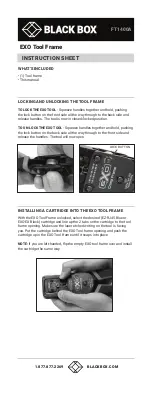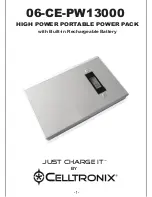
10
CARE AND MAINTENANCE
Always remove tool from air supply before performing any maintenance on tool.
An in-line oiler (not included) is recommended to be installed to air supply. It will help increase tool
life and keep the tool properly lubricated. The in-line oiler should be regularly checked and filled
with air tool oil as needed. To check if the in-line oiler is properly lubricating the tool, place a sheet
of paper next to the tool’s exhaust ports while holding the throttle completely open for 30 seconds.
The in-line oiler is properly set when a light stain of oil collects on the paper. Excessive amounts of
oil should be avoided.
In the event that it becomes necessary to store the tool for an extended period of time, the tool
should receive a generous amount of lubrication right before being stored. After being well
lubricated, the tool should be run for approximately 30 seconds to ensure oil has been evenly
distributed throughout the tool. The tool should be stored in a clean and dry environment away
from the reach of children. Recommended lubricants: Use air-tool oil or any other high grade
turbine oil containing moisture absorbent, rust inhibitors, metal wetting agent and an EP (extreme
pressure) additive. Consult your local retailer for further assistance in selecting which air tool oil is
best suited for proper lubrication.
STORING:
Tool must be well cleaned and lightly lubricated before storing.
Store air tool in a dry safe place, out of the reach of children.
1. Flush the tool with air-tool oil or gum
solvent.
2. Lubricate the tool.
3. Adjust the compressor regulator so that tool
operates at a maximum of 90 PSI.
4. Tighten and seal hose fittings if leaks are
found. Use sealing tape.
5. a. Be sure the hose is the proper size.
Long hose or tools using large volumes
of air may require a hose with an I.D. of
1/2 in. or larger depending on the total
length of the hoses.
b. Do not use a multiple number of hoses
connected together with quick-connect
fittings. This causes additional pressure
drops and reduces the tool power.
Directly connect the hoses together.
6. Water in tank; drain tank. (See air
compressor manual). Oil tool and run
until no water is evident. Oil tool again
and run 1-2 seconds.
Tool runs
slowly or will
not operate.
1. Grit or gum in tool.
2. No oil in tool.
3. Low air pressure.
4. Air hose leaks.
5. Pressure drops.
6. Moisture blowing
out of tool exhaust.
PROBLEM
TROUBLESHOOTING
CORRECTIVE ACTION
POSSIBLE CAUSE











































